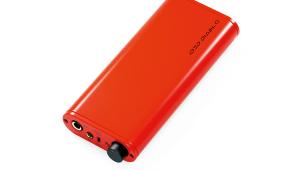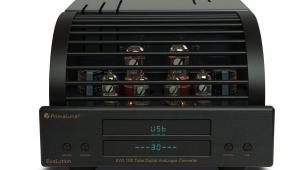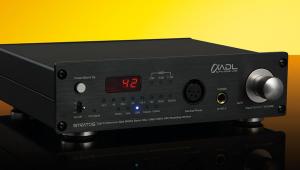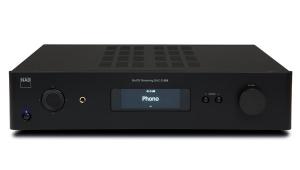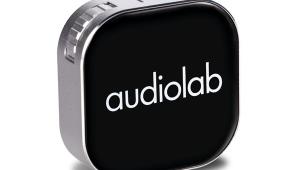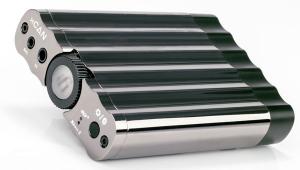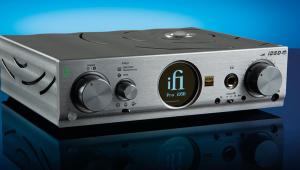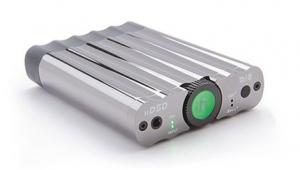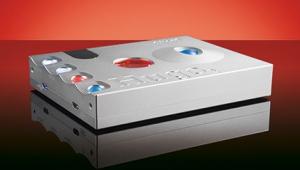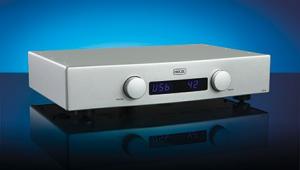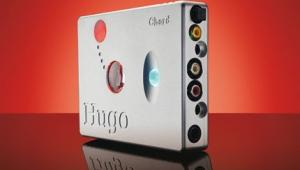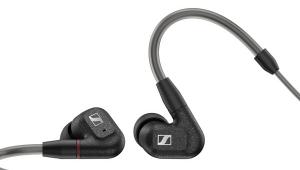World Exclusive Review: Audiolab M-DAC+
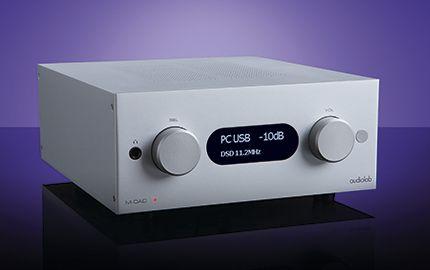
 And so it comes to pass that after nearly five years, the Audiolab M-DAC finally gets itself a bigger brother! Rather like that famous difficult second album that recording artists battle with, it was never going to be easy for Audiolab to improve on one of the strongest products it has ever released. When it came out, the original M-DAC (HFC 359) had no real rivals at its £600 price point. Indeed, it got off to a good start because it was essentially the digital converter section of the 8200A CD player – itself one of the best silver disc spinners under £1,500, thanks to designer John Westlake’s prodigious talent. Also, interestingly, it was one of the first DACs to use the (then) new and highly regarded ESS Sabre 9018 DAC chips. Basically, the M-DAC had a great start in life.
And so it comes to pass that after nearly five years, the Audiolab M-DAC finally gets itself a bigger brother! Rather like that famous difficult second album that recording artists battle with, it was never going to be easy for Audiolab to improve on one of the strongest products it has ever released. When it came out, the original M-DAC (HFC 359) had no real rivals at its £600 price point. Indeed, it got off to a good start because it was essentially the digital converter section of the 8200A CD player – itself one of the best silver disc spinners under £1,500, thanks to designer John Westlake’s prodigious talent. Also, interestingly, it was one of the first DACs to use the (then) new and highly regarded ESS Sabre 9018 DAC chips. Basically, the M-DAC had a great start in life.
The new version is considerably larger than the original, mainly on account of the fact the power supply has been brought inside the unit. It’s a high-quality toroidal affair using multiple windings to feed separate analogue and digital rectification stages. From there, multiple power supply sections feed the necessary voltages to each area of the DAC, keeping any crossover interference to a minimum, Audiolab says. It makes this new box quite a bit heavier than its predecessor, and it stands taller and deeper too. Beautifully made from aluminium, its casework has been updated visually to match the look of the new 8300 series. Hence a smoother and less crowded front panel with two main controls replacing the four buttons and one knob of the M-DAC. One selects volume, and the other is a multi-function controller for source and setup. It’s considerably nicer to use than the original, although the central OLED display is smaller than the M-DAC and less informative.
As a package, the M-DAC+ feels far more like a piece of budget esoterica, than its predecessor. It’s much more svelte and grown up, whereas the M-DAC seems more of a button-pushing geek’s dream. Around the back, there are more digital inputs than ever, including an AES/EBU socket and an additional USB Type A input – ideal for connecting Apple devices – alongside the existing USB Type B connection. These join the M-DAC’s twin coaxial and twin optical digital inputs, optical and coaxial digital outputs, single-ended RCA and balanced XLR analogue outputs and the usual 12V trigger loop. With the choice of fixed or variable outputs, the J-FET Class A output stage can feed an integrated amplifier or a power amp direct.
The M-DAC+ now runs PCM right up to its 32-bit/384kHz ragged edge via USB, meaning it is unlikely to be obsolete for a while. But the headline news is DSD support (DSD64, DSD128 and DSD256), which Audiolab says: “has an important role to play in the developing high-resolution downloading and streaming scene”. True, but the emphasis is very much on the future because right now there’s still a paucity of DSD files of any type. In truth, most users will be using this new Audiolab for a little bit of high-resolution PCM file playback via USB, and a lot of 16-bit/44kHz CD playback via one of the coaxial inputs. To this end, the company has included a number of user-selectable digital filters, letting people tune the sound to their taste. The plus inherits seven PCM filter settings from the original, and adds four more for DSD playback. It’s difficult to be definitive about the sound of these because it depends very much on your system and ancillaries. I’d recommend new purchasers spend a few weeks switching these filters around to find their favourites, although they may find they vary from recording to recording, or even track to track.
Sound quality
It wasn’t until the arrival of the Audiolab M-DAC in 2011 that cash-strapped audiophiles had a genuinely flexible yet fine-sounding DAC. It was so good at its £600 price point that it turned the market upside down. The new M-DAC+ doesn’t do this – think of it as a brilliant refinement, rather than the reinvention of the hi-fi wheel. It brings worthwhile improvementsto pretty much every aspect of the M-DAC, from far superior operation sophistication to a greater musicality. If there was ever a criticism of the original, then it was the slight sense of musical constraint. Although detailed, powerful and commanding in the way it made music, it was never quite as lucid or as fluid as I would have liked. The new DAC addresses this to a great extent, bringing a more natural and organic feel. It sounds less mechanical and less ‘electronic’ and seems better than its predecessor at disappearing and simply letting the music flow.
For example, Badly Drawn Boy’s Something To Talk About is a fine example of a modern pop recording; the original M-DAC proved lots of fun with a bold and explicit sound, but the new one removes the slightly processed feel. Tonally, the sound seems less chromium plated, and the listener is better able to immerse themself in the music, enjoying its wonderful singalong quality and honey-smooth vocals. There’s less of a sense that you’re listening to a budget digital source, and everything sounds more natural and less forced. Percussion instruments play gently but expressively without throwing themselves at you, and the song lopes along joyously.
Switch to some classic electronica in the shape of Kraftwerk’s The Robots, and you get the same effect. Even though it’s not an acoustic track, it still sounds less processed and more natural through the new M-DAC+. The vast size of the soundstage is just as impressive as before, but it’s the subtle details inside that make the difference. The music appears to fall back to a deeper, darker silence, and the rhythm section seems less crisp and better resolved – it’s more nuanced and doesn’t simply just hit you in a blunt fashion. All the power is there as before but it’s delivered in a more finessed and natural way. Notes appear to decay gently and fall off into space, rather than simply just ‘falling off a cliff’ as its predecessor was prone to do before. It’s a cliché, but this new box sounds so much more ‘analogue’ than the original.
Pro Plus
You’d never say the Plus is dramatically better, but it’s certainly comprehensively so. This is most noticeable when you move to higher-resolution source material, such as a 24/192 recording of REM’s Texarkana. Once again it delivers a great sound for its price, one that is balanced and refined yet powerful and immersive. There’s a lovely rhythmic gate to the M-DAC+ and it speeds the song along, focusing on that great driving bassline from Mike Mills. The rest of the mix isn’t bad either, with the band’s distinctive, crunchy Rickenbackers carried with power and passion. The drum kit is great too, with a super-tight, cutting snare sound and some lovely cymbal work. Indeed, the high frequencies are very well resolved, sounding clean and devoid of noise. This new DAC still isn’t quite the most soulful around, but it’s now certainly one of the most transparent and has bundles of life and energy too.
Indeed, it’s this detailed and neutral character that makes it so good across a wide range of music. It’s particularly suited to acoustic programme material, including classical. A Phillips recording of Debussy’s Submerged Cathedral is a joy. This prelude is wonderfully ethereal and atmospheric if properly reproduced, and the M-DAC+ proves well able to do this. Its handling of the subtle dynamic accenting of the piano is first rate and it skilfully delivers the pianist’s rhythmic input too. Tonally, it isn’t the sweetest and most sumptuous-sounding digital converter I’ve ever heard, but it is certainly an improvement on its predecessor and gives an unerringly balanced and satisfying sound. The result is a compelling rendition of this fine piece of music, and the pattern continues with a DSD file of Alex de Grassi’s The Water Garden, which has a lovely, lilting, unforced quality and the guitar sparkles with harmonics in a way that you simply don’t expect from digital.
Conclusion
This is a clear step forward from the original M-DAC, and makes the original look rather average value for money. The Plus is way more sophisticated operationally, and has a usefully smoother and more subtle sound that pushes it one rung up the ladder. The only regret is the display, which isn’t as informative as its predecessor. Superb in pretty much every other respect for its price, this new DAC is an essential audition. DP
DETAILS
PRODUCT: Audiolab M-DAC+
PRICE: £800
ORIGIN: UK/China
TYPE: Digital-to-analogue converter
WEIGHT: 3.7kg
DIMENSIONS (WxHxD): 247 x 114 x 292mm
FEATURES
● ESS Sabre32 9018 DAC chip
● PCM up to 32-bit/384kHz; DSD64/128/256
● Digital inputs: 1x AES/EBU, 1x USB-A, 1x USB-B, 2x coaxial, 2x optical
● RCA phono, balanced XLR outputs
DISTRIBUTOR: IAG
TELEPHONE: 01480 447700
WEBSITE: audiolab.co.uk
 Read the full review here
Read the full review here
 |
Inside this month's issue:
Q Acoustics 3020c standmount loudspeakers, Perlisten R10s active subwoofer, Quad 33 and 303 pre/power amps, Acoustic Solid Vintage Full Exclusive turntable, newcomer Fell Audio Fell Amp and Fell Disc and lots, lots more...
|



